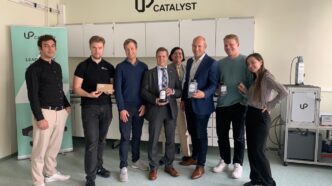Europe is racing to secure critical materials for its energy transition—and graphite is high on the list. As electric vehicle demand grows, the continent is bracing for a severe shortfall in graphite supply, with projections estimating a gap of nearly 800,000 metric tonnes by 2030. Around 15% of that deficit will affect Europe alone. But one Estonian climate tech startup has a bold solution—convert excess CO₂ into valuable graphite.
Tallinn-based UP Catalyst has just landed an €18 million venture loan from the European Investment Bank (EIB). The funding will help the company scale its breakthrough molten salt electrolysis technology, which turns industrial carbon emissions into battery-grade graphite and carbon nanotubes—key materials in EV batteries, defense systems, polymers, and construction materials.
Revolutionizing Graphite Production with CO₂
What sets UP Catalyst apart is its energy-efficient, low-emission process. Unlike traditional methods that rely on fossil fuels, the company’s technology uses less power and emits significantly less carbon. It’s a sustainable alternative designed to operate at scale, and according to the company, it could meet up to 50% of Europe’s graphite demand shortfall in the near future.
“Our mission is to fund innovative net-zero technologies that reduce environmental impact and strengthen Europe’s competitiveness,” said EIB Vice-President Thomas Östros. “UP Catalyst aligns with that vision by offering cutting-edge carbon capture and utilization technologies.”
The investment falls under the InvestEU initiative, a program focused on building sustainable European industry and reducing dependency on imported raw materials. UP Catalyst is already shifting gears toward commercialization. Its graphite is now being tested in GEN3alpha battery cells, with large-scale validation underway for deployment by 2025.
A Strategic Move Toward Local, Sustainable Supply Chains
“This investment from the EIB is a major milestone for us,” said Rait Maasikas, CEO of UP Catalyst. “It validates not only our technology and production capabilities but also our role in strengthening Europe’s industrial resilience and creating a more autonomous raw material supply chain.”
UP Catalyst has confirmed that its graphite matches the performance and quality of fossil-based materials. That opens new doors in both energy storage and defense applications. Backed by EIB funding, the startup plans to ramp up its annual output to 1,350 tonnes of graphite and 270 tonnes of carbon nanotubes by 2027, all while capturing and reusing around 6,000 tonnes of CO₂ per year.
The company took a major step forward in 2024 by opening a new production facility in Estonia and launching in-house testing services for its carbon materials. Based on a cradle-to-gate Life Cycle Assessment, the production method boasts one of the lowest carbon footprints for battery-grade graphite and the lowest for carbon nanotubes currently available on the market.
In recognition of its impact, UP Catalyst was recently named a strategic project partner by the European Commission under the Critical Raw Materials Act (CRMA). This designation gives the company a key role in the EU’s efforts to boost domestic sourcing of raw materials.
With this fresh funding and a growing reputation, UP Catalyst is betting on a future where turning emissions into essential materials becomes standard. And as the pressure mounts to secure graphite for Europe’s green transition, this Estonian innovator may prove to be a vital piece of the puzzle.













